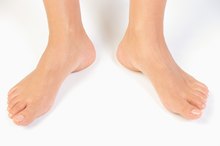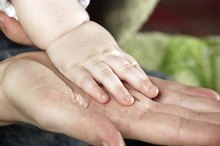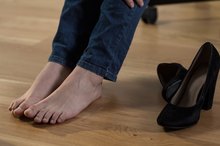My Feet & Hands Are Swelling After Having a Baby
Postpartum swelling in your feet and hands, also called edema, occurs when fluid and blood becomes trapped in the tissues of your body 2. Although swelling can be frustrating, it typically subsides several weeks after giving birth. Though understanding why postnatal extremity swelling occurs can help rule out a serious complication or condition, you should still consult your doctor for professional diagnosis and advice.
If you are experiencing serious medical symptoms, seek emergency treatment immediately.
Symptoms
Swelling in your hands and feet after having a baby can vary from mild to extreme. The skin of your extremities can appear shiny, puffy, inflamed and stretched. It may stay sunken in for many seconds if you push on it. Beside the hands and feet, swelling can also affect body parts such as the ankles, abdomen and legs.
- Swelling in your hands and feet after having a baby can vary from mild to extreme.
Causes
Swollen Ankles After Having a Baby
Learn More
Your body retains and produces excess fluid and blood during pregnancy. This fluid can remain in your hands and feet for several weeks following delivery. In addition, the hormonal fluctuations that occur after birth can trigger swelling and extra buildup of fluid. Edema can also develop if you sit or lie for long periods of time, such as when feeding your baby or recovering from birth or a Cesarean section. Salty foods and the reoccurrence of your menstrual period can also trigger fluid buildup.
- Your body retains and produces excess fluid and blood during pregnancy.
- Salty foods and the reoccurrence of your menstrual period can also trigger fluid buildup.
Treatments
Eat foods that are high in potassium, like bananas, to help reduce swelling. Wear hose or supportive socks and elevate your feet and hands as much as possible to help fluid drain away from them. Compress your hands and feet with a cool washcloth. Massage, shake and move your hands and feet as much as possible to help move the excess blood and fluid back toward your heart.
- Eat foods that are high in potassium, like bananas, to help reduce swelling.
- Wear hose or supportive socks and elevate your feet and hands as much as possible to help fluid drain away from them.
Warnings
How to Shrink a Swollen Ring Finger
Learn More
Contact a doctor if swelling of your hands and feet is persistent or painful. Go to the emergency room if swelling is accompanied by pain in your chest, head pain, problems breathing, severe pain in the hands and feet or shortness of breath. These could be symptoms of a serious condition such as swelling of the lungs, congestive heart failure, high blood pressure or a blood clot.
Related Articles
References
- "The Complete Book of Pregnancy and Childbirth"; Sheila Kitzinger; 1996
- BabyCenter: Postpartum: Swelling (Edema)
- American Pregnancy Association: Swelling During Pregnancy
- MayoClinic.com; Edema; Oct. 13, 2009
- Rao S, Riskowski JL, Hannan MT. Musculoskeletal conditions of the foot and ankle: assessments and treatment options. Best Pract Res Clin Rheumatol. 2012;26(3):345-368. doi:10.1016/j.berh.2012.05.009
- Ragab G, Elshahaly M, Bardin T. Gout: An old disease in new perspective - A review. J Adv Res. 2017;8(5):495-511. doi:10.1016/j.jare.2017.04.008
- Youn YJ, Lee J. Chronic venous insufficiency and varicose veins of the lower extremities. Korean J Intern Med. 2019;34(2):269-283. doi:10.3904/kjim.2018.230
- American Heart Association. Risk Factors for Venous Thromboembolism (VTE). Updated March 30, 2017.
- McDaid A, Logette E, Buchillier V, et al. Risk prediction of developing venous thrombosis in combined oral contraceptive users. PLoS ONE. 2017;12(7):e0182041. doi:10.1371/journal.pone.0182041
- National Health Service (NHS). Swollen ankles, feet and fingers in pregnancy. Updated February 28, 2018.
Writer Bio
Rose Erickson has been a professional writer since 2010. She specializes in fitness, parenting, beauty, health, nutrition and saving money, and writes for several online publications including The Krazy Coupon Lady. She is also a novelist and a mother of three.








